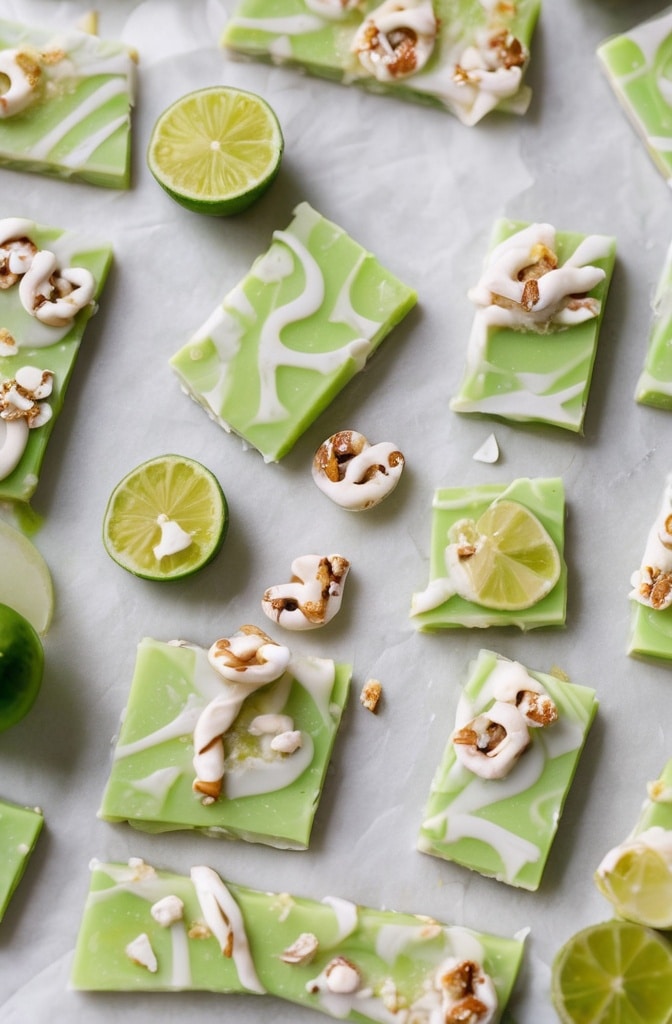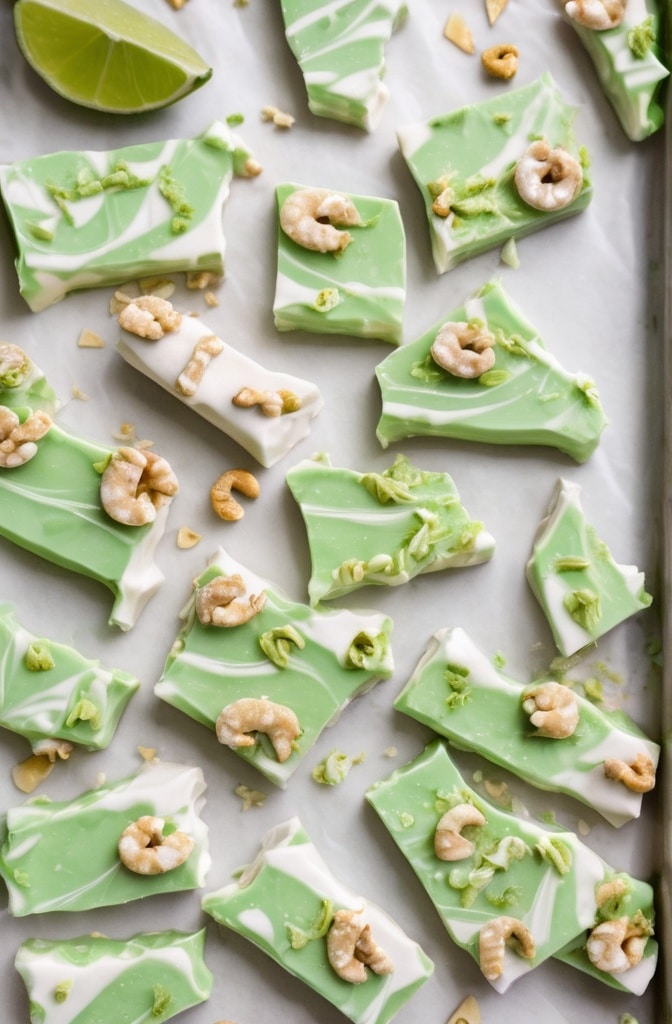There’s something magical about the moment when chocolate meets cocktail. I still remember the first time I encountered booze-infused confections at a high-end chocolatier in New Orleans the unexpected marriage of flavors was an absolute revelation. Delightful Margarita Bark Candy with Tequila represents the perfect fusion of two beloved indulgences: the classic cocktail and velvety chocolate, creating an adult confection that’s both elegant and whimsical.
This recipe isn’t just another sweet treat; it’s an experience in edible cocktail craftsmanship that transforms the vibrant, zesty flavors of a margarita into a sophisticated candy format. The combination of quality white chocolate, authentic tequila, fresh citrus, and that signature salt finish creates a multilayered sensory adventure that’ll impress even the most discerning palates.
Ingredients & Substitutions
For the Tequila-Lime White Chocolate Base:
- 16 oz (450g) premium white chocolate, chopped or chips
- 3 tablespoons silver (blanco) tequila
- 2 tablespoons fresh lime juice
- 2 tablespoons lime zest, divided
- 1/2 teaspoon pure vanilla extract
- 1/4 teaspoon citric acid (optional, for extra tanginess)
For the Tequila-Infused Dark Chocolate Drizzle:
- 4 oz (115g) high-quality dark chocolate (70% cocoa)
- 1 tablespoon reposado tequila
- 1/4 teaspoon lime oil or 1/2 teaspoon lime zest
For the Finishing Touches:
- 2 tablespoons flaky sea salt (Maldon works beautifully)
- 1 tablespoon dehydrated lime zest or lime sugar
- 1 tablespoon coarse sanding sugar
- Additional lime zest for garnish
- Edible gold dust or flakes (optional for special occasions)
White chocolate forms the base of this confection, but dosen’t feel limited to standard grocery store varieties. Look for cocoa butter-based white chocolate (at least 30% cocoa butter) for superior melting and texture—Valrhona Ivoire, Callebaut, or even Ghirardelli will yield excellent results. For those avoiding dairy, coconut-based white chocolate alternatives can work, though you’ll need to adjust the tequila slightly downward as these alternatives tend to seize more easily with liquid additions.
The tequila selection matters enormously. A good-quality blanco tequila provides clean, bright agave notes without overwhelming the delicate white chocolate. Avoid mixto tequilas (those not made from 100% blue agave), as they can introduce harsh flavors. If you prefer avoiding alcohol altogether, try substituting with 1 tablespoon of lime extract and 2 tablespoons of agave syrup reduced with a pinch of salt—it won’t be identical, but captures some of the essence.
Step-by-Step Instructions

Preparing the White Chocolate Base:
- Line a 9×13-inch baking sheet with parchment paper, ensuring the paper extends slightly up the sides for easy removal later. Proper preparation prevents frustrating sticking issues that can ruin your carefully crafted bark.
- Create a double boiler by placing a heat-proof bowl over a pot with about an inch of barely simmering water, making sure the bowl doesn’t touch the water surface. This gentle, indirect heat prevents white chocolate from becoming grainy or seizing.
- Add the chopped white chocolate to the bowl and melt slowly, stirring occasionally with a silicone spatula. White chocolate is notoriously temperamental—overheating it by even a few degrees can cause it to become grainy and unusable, so patience is critical here.
- Once the chocolate is about 80% melted, remove it from the heat and continue stirring until completely smooth. The residual heat will complete the melting process while protecting the chocolate’s delicate structure.
- Allow the chocolate to cool slightly, to about 85°F (29°C) if you have a thermometer, or until it no longer feels hot to the touch on your inner wrist. This cooling step is essential—add liquids to hot white chocolate and you’ll likely end up with a grainy disaster rather than a smooth canvas for your margarita flavors.
- In a small bowl, combine the tequila, lime juice, half the lime zest, vanilla extract, and citric acid if using. Whisk them together quickly, then have this mixture ready before proceeding to the next step.
- Working swiftly but steadily, drizzle the tequila-lime mixture into the cooled white chocolate while stirring continuously. Don’t dump it all at once—the gradual incorporation helps prevent shocking the chocolate, which can cause seizing.
- If you notice the chocolate beginning to thicken too much or appear slightly grainy, add 1/2 teaspoon of neutral vegetable oil and increase your stirring speed. Sometimes this can rescue a mixture that’s on the verge of breaking.
- Pour the flavored white chocolate onto the prepared baking sheet, using an offset spatula to spread it into an even layer about 1/4-inch thick. The thickness dramatically affects both the texture and the eating experience—too thin and it becomes fragile, too thick and it loses its delicate melt-in-your-mouth quality.
Creating the Tequila Dark Chocolate Drizzle:
- In a clean bowl, repeat the double-boiler method to melt the dark chocolate. Dark chocolate is more forgiving than white, but still benefits from gentle treatment.
- Once melted, remove from heat and stir in the reposado tequila and lime oil or zest. The deeper, woodier notes of reposado complement the richness of dark chocolate, creating a sophisticated counterpoint to the brighter white chocolate base.
- Transfer the dark chocolate mixture to a small piping bag with a fine tip or a plastic sandwich bag with a tiny corner snipped off. Working quickly while both chocolates are still slightly fluid, drizzle the dark chocolate over the white chocolate in whatever pattern appeals to you—zigzags, swirls, or even geometric designs can add visual interest.
- Use a toothpick or the tip of a paring knife to lightly swirl the dark chocolate into the white, creating a marbled effect that mimics the artistic presentation of craft cocktails. Don’t overdo this step—a few deliberate swirls create better visual impact than excessive mixing.
Adding the Finishing Touches:
- While the chocolate is still tacky but not completely set, sprinkle the flaky sea salt, dehydrated lime zest or lime sugar, and coarse sanding sugar evenly across the surface. The timing here is crucial—add toppings too soon and they’ll sink in, too late and they won’t adhere properly.
- For special occasions, lightly dust select areas with edible gold dust using a small, dry brush. This optional step adds a touch of luxury and elegance that elevates the bark from mere candy to sophisticated confection.
- Allow the bark to set completely at cool room temperature (about 1-2 hours) or refrigerate for 30 minutes if you’re in a humid environment. Avoid the freezer, as rapid temperature changes can cause condensation when the bark is removed, potentially ruining the finish.
- Once fully set, gently lift the parchment paper to remove the bark from the baking sheet, then break or cut the bark into irregular pieces. Rough, uneven edges contribute to the artisanal appearance that makes this confection so appealing.
Cooking Techniques & The Science Behind the Magic
The success of margarita bark candy hinges on understanding chocolate’s temperamental nature. Chocolate is an emulsion—a careful balance of cocoa solids, cocoa butter, and in white chocolate’s case, milk solids. When we add water-based ingredients like tequila and lime juice, we risk breaking this emulsion. This explains why we cool the chocolate before adding liquids and why we incorporate them slowly.
The addition of citric acid serves a fascinating purpose beyond flavor enhancement. It actually helps stabilize the emulsion by slightly lowering the pH, which can prevent the chocolate from “breaking” when the acidic lime juice is added. This is the same principle employed in high-end pastry kitchens when creating water-based ganaches.
The flaky sea salt doesn’t just add a contrasting flavor—it recreates the distinctive salt rim of a classic margarita while also employing the culinary principle of flavor layering. Salt actually enhances our perception of sweetness while simultaneously reducing bitterness, creating a more complex and balanced flavor profile. It’s the same reason salted caramel became such a revolutionary flavor combination.
The dual-chocolate approach isn’t merely aesthetic; it creates textural and flavor complexity. Dark chocolate has a lower cocoa butter content than white chocolate, giving it a firmer texture at room temperature. This textural contrast provides a satisfying mouthfeel variation as you bite through the softer white chocolate base and encounter the slightly firmer dark chocolate swirls.
Serving & Pairing Suggestions
Presentation elevates this already impressive confection. For cocktail parties, arrange larger, more dramatic pieces on a slate board alongside fresh lime wedges and perhaps a small dish of additional flaky salt for guests who enjoy a stronger salt hit. The visual reference to the classic cocktail makes the connection immediately apparent.
For a dessert course, serve smaller pieces in cocktail glasses alongside the actual margarita that inspired them. The parallel tasting experience creates a unique sensory exploration that sophisticated diners will appreciate.

The bark pairs beautifully with aged tequilas, particularly añejos with vanilla and caramel notes. The contrast between the bright, zesty candy and the deeper, woodier spirit creates a balanced tasting experience. For non-alcoholic pairings, a lime-infused sparkling water cleanses the palate between bites.
Consider serving this bark as part of a Mexican-inspired dessert platter alongside cinnamon-dusted churros and small cups of spiced hot chocolate. The temperature and texture contrasts create a memorable end to a meal.
For gifting, package pieces of the bark in clear cellophane bags tied with raffia and a dried lime wheel, or in small tequila glasses wrapped in colorful tissue. The presentation telegraphs the sophisticated flavor profile before the recipient even tastes it.
Storage & Make-Ahead Tips
Properly stored in an airtight container, margarita bark will maintain its quality for up to two weeks at cool room temperature (65-70°F/18-21°C). In warmer environments, refrigeration is recommended, but allow the bark to come to room temperature before serving to fully appreciate its flavor nuances and texture.
The alcohol content helps preserve the bark slightly longer than traditional chocolate confections, while also preventing the chocolate from hardening excessively in the refrigerator. This makes it an excellent make-ahead option for entertaining.
For extended storage, the bark can be frozen for up to three months. Wrap it carefully in plastic wrap, then aluminum foil to prevent freezer burn and flavor transfer. Thaw overnight in the refrigerator, then bring to room temperature before serving.
Conclusion
Margarita bark candy with tequila represents the best of culinary innovation—taking familiar flavors and transforming them into something unexpected yet immediately recognizable. The balance of sweet white chocolate, tangy lime, complex tequila notes, and that perfect hint of salt creates a sophisticated adult confection that honors its cocktail inspiration.
The techniques employed—from the careful chocolate tempering to the deliberate layering of flavors—reflect professional confectionery practices, yet the recipe remains accessible to serious home cooks. The result is a versatile treat that works equally well for casual gatherings or elegant affairs.
What makes this recipe truly special is its ability to capture the essence of a beloved cocktail in a portable, giftable format. It’s not simply candy with tequila added—it’s a thoughtful reinterpretation that considers every element of the original drink and finds its chocolate equivalent.
FAQs about Delightful Margarita Bark Candy with Tequila
Q: Can I use flavored tequila for this recipe?
A: While traditional silver tequila produces the most authentic margarita flavor, infused varieties like citrus or jalapeño tequila can create interesting variations. Just be aware that strongly flavored tequilas may compete with rather than complement the lime and chocolate. If experimenting with flavored options, reduce the quantity to 2 tablespoons for the first test batch.
Q: My white chocolate seized when I added the tequila mixture. What happened?
A: Chocolate seizing occurs when even small amounts of moisture cause the dry particles in chocolate to clump together. To prevent this, ensure your chocolate has cooled sufficiently before adding liquids, incorporate the tequila-lime mixture very gradually while stirring constantly, and consider adding a stabilizing agent like additional cocoa butter (1 teaspoon) to your chocolate before introducing any liquids.
Q: How strong is the alcohol flavor in the finished product?
A: The finished bark retains approximately 70% of the alcohol content, creating a noticeable but not overwhelming tequila presence. The flavor is more pronounced than the actual alcohol effect—you’d need to consume a substantial amount of bark to experience any effects similar to drinking a margarita. To increase the tequila flavor without adding more liquid, try brushing the set chocolate with additional tequila using a pastry brush before adding the toppings.
Q: Can I create other cocktail-inspired chocolate barks using this same technique?
A: Absolutely! This methodology works beautifully for many cocktail interpretations. For a mojito version, substitute white rum for tequila and fresh mint for some of the lime zest. For a piña colada variation, use white rum and incorporate dried pineapple pieces and toasted coconut as toppings. The key is maintaining the proper ratio of liquid to chocolate—generally not exceeding 3-4 tablespoons of liquid per pound of chocolate.
Q: Is this recipe suitable for high-humidity environments?
A: High humidity presents challenges for any chocolate work. In humid conditions, consider increasing the chocolate by 2 ounces and decreasing the total liquid by 1 tablespoon. Adding 1/2 teaspoon of food-grade cocoa butter or paramount crystals to the melting chocolate can also improve stability. Store the finished bark in the refrigerator, but always serve at room temperature for optimal flavor and texture.

